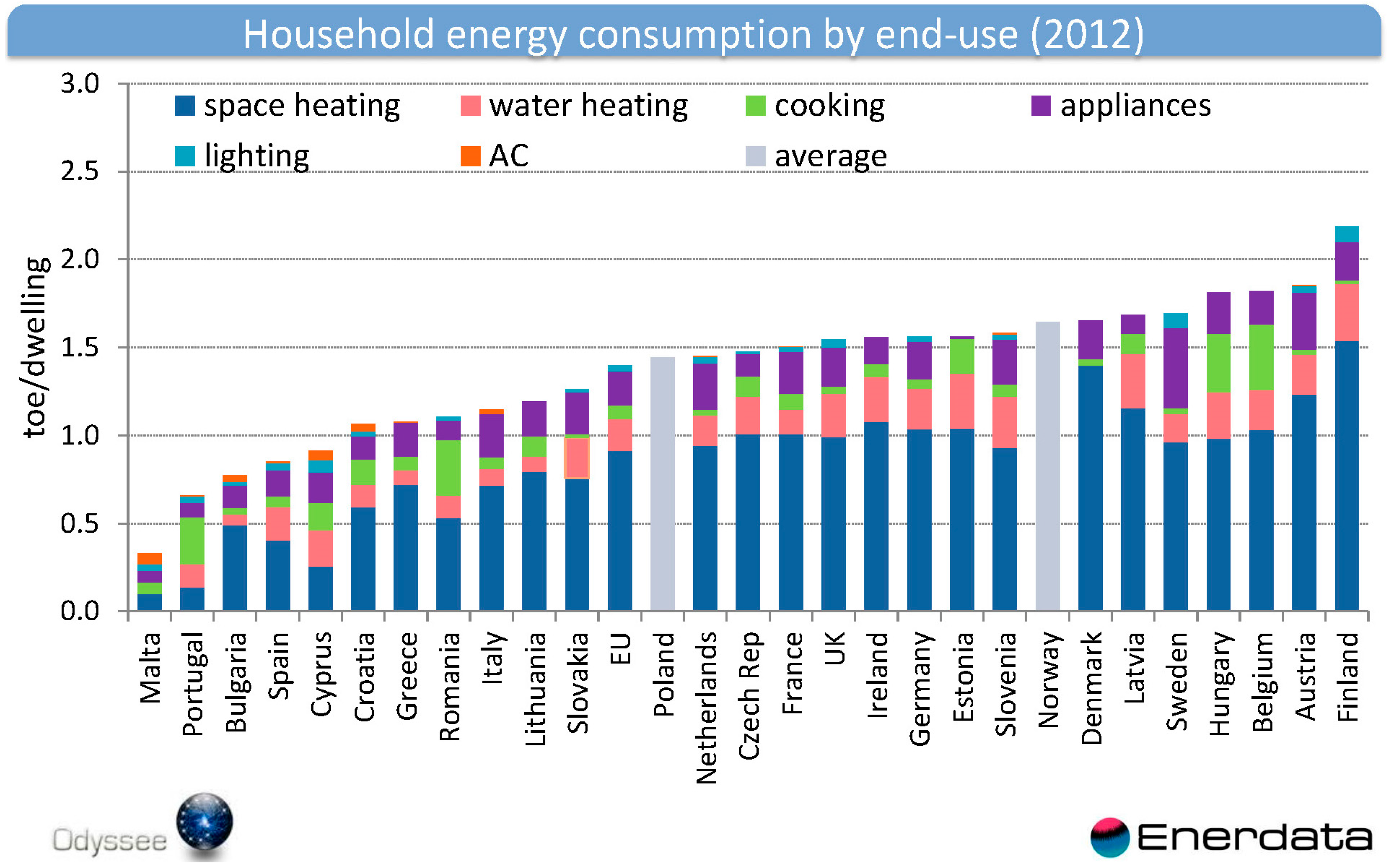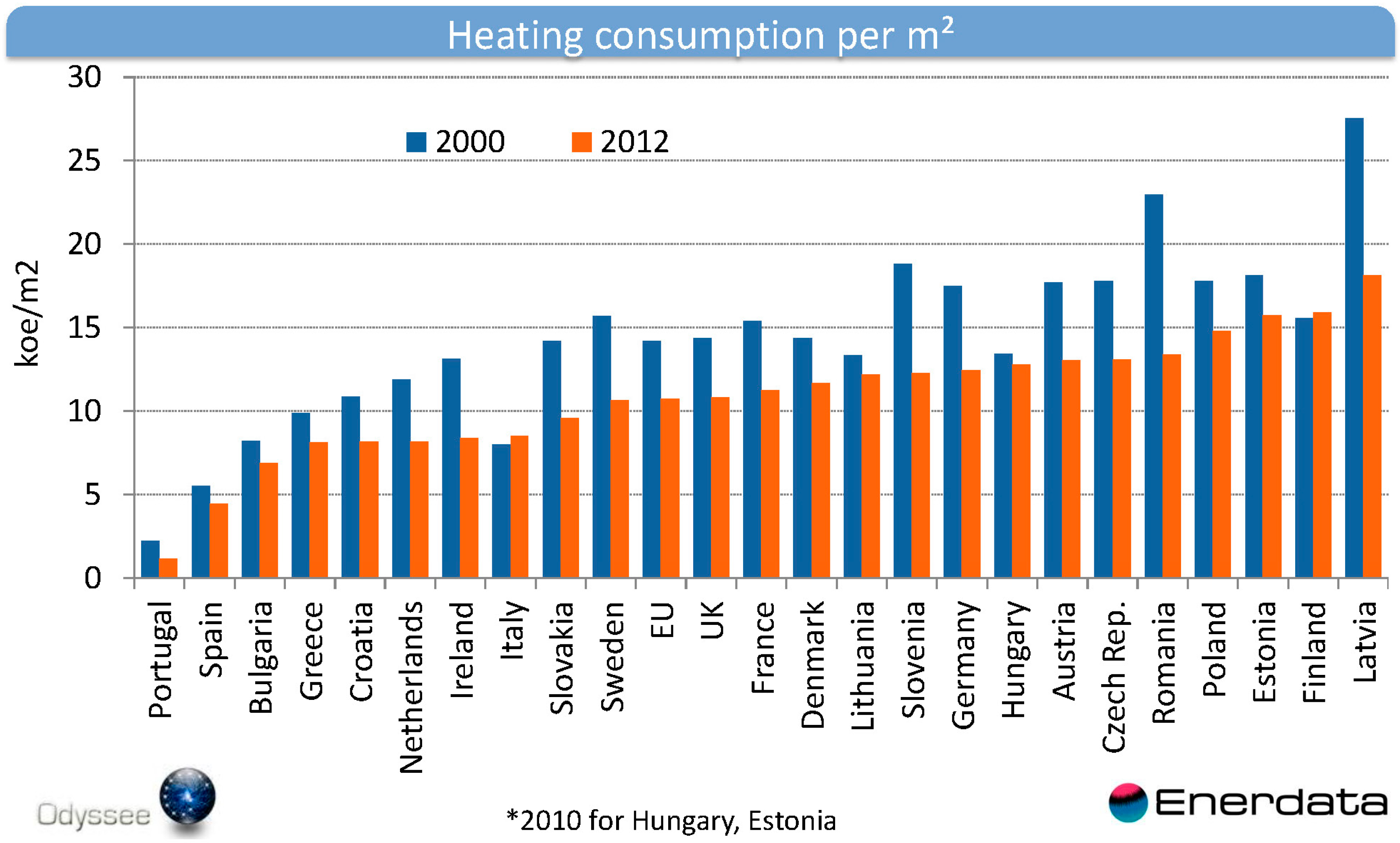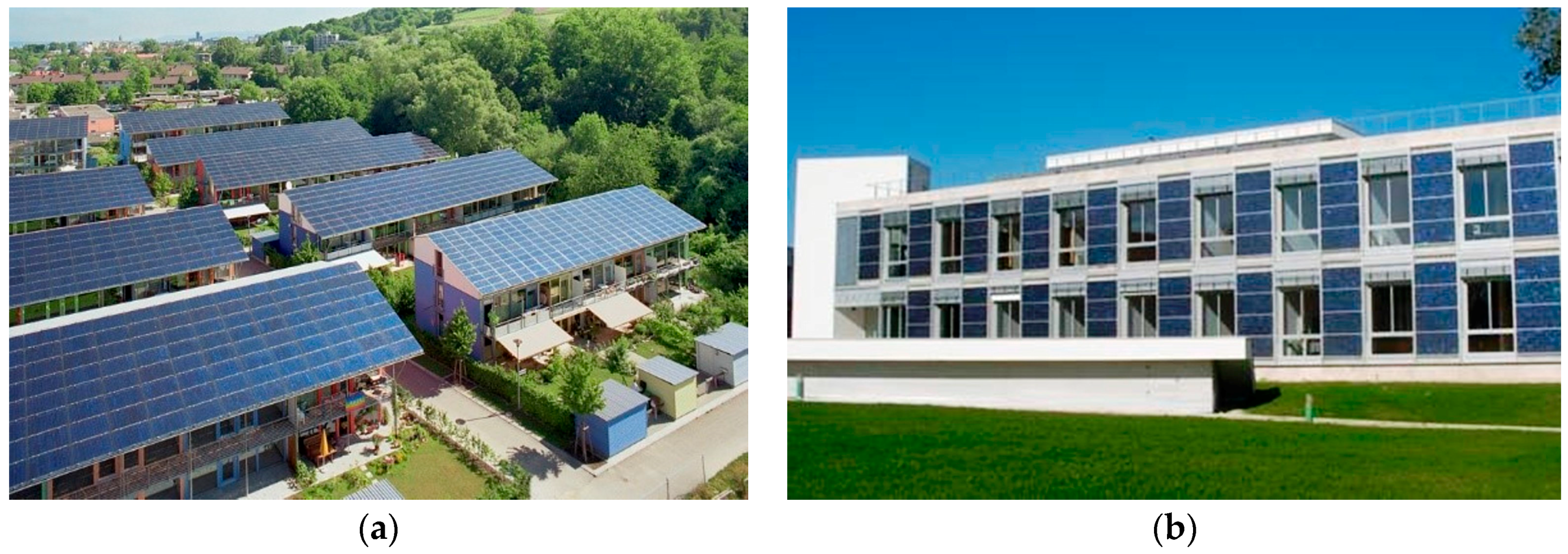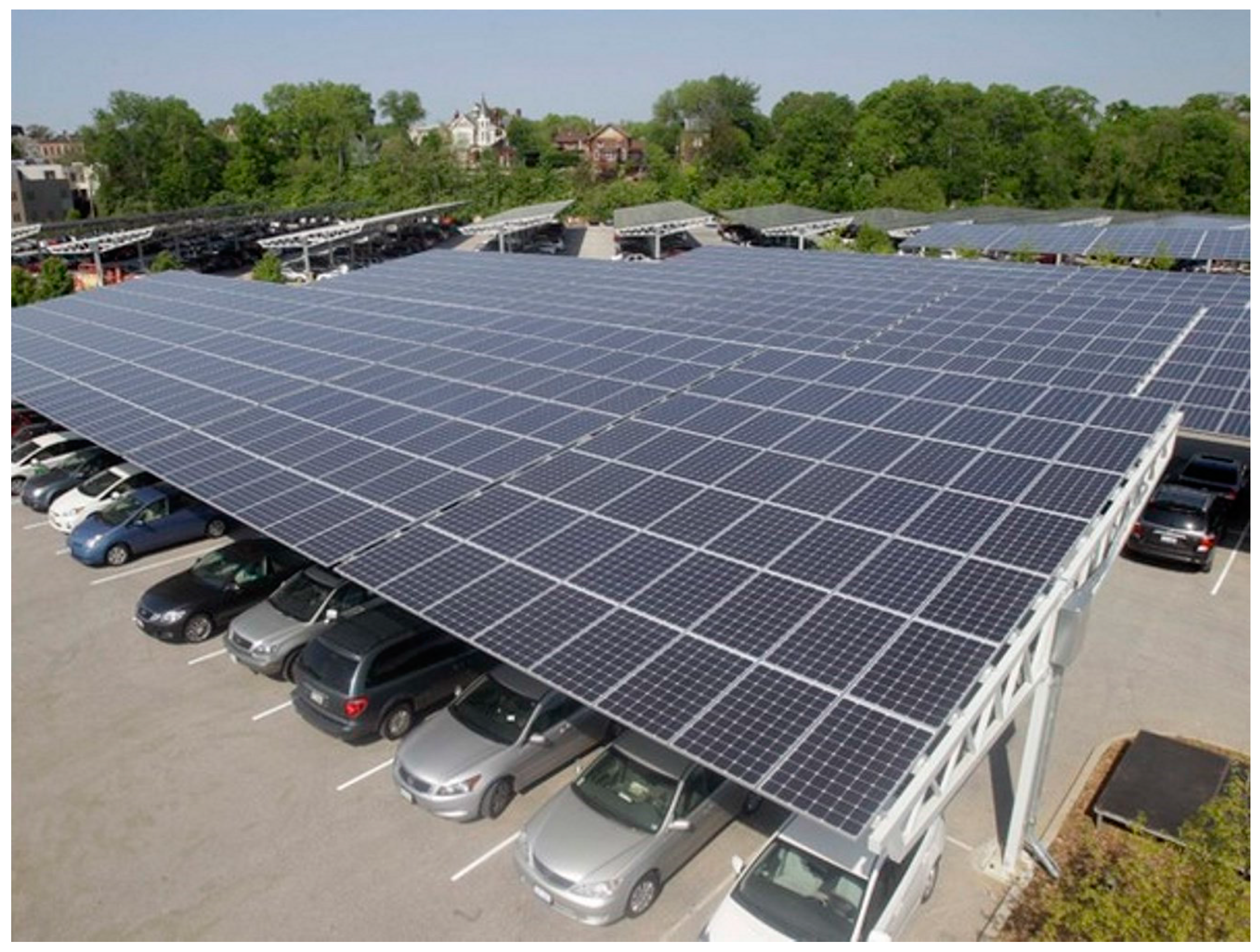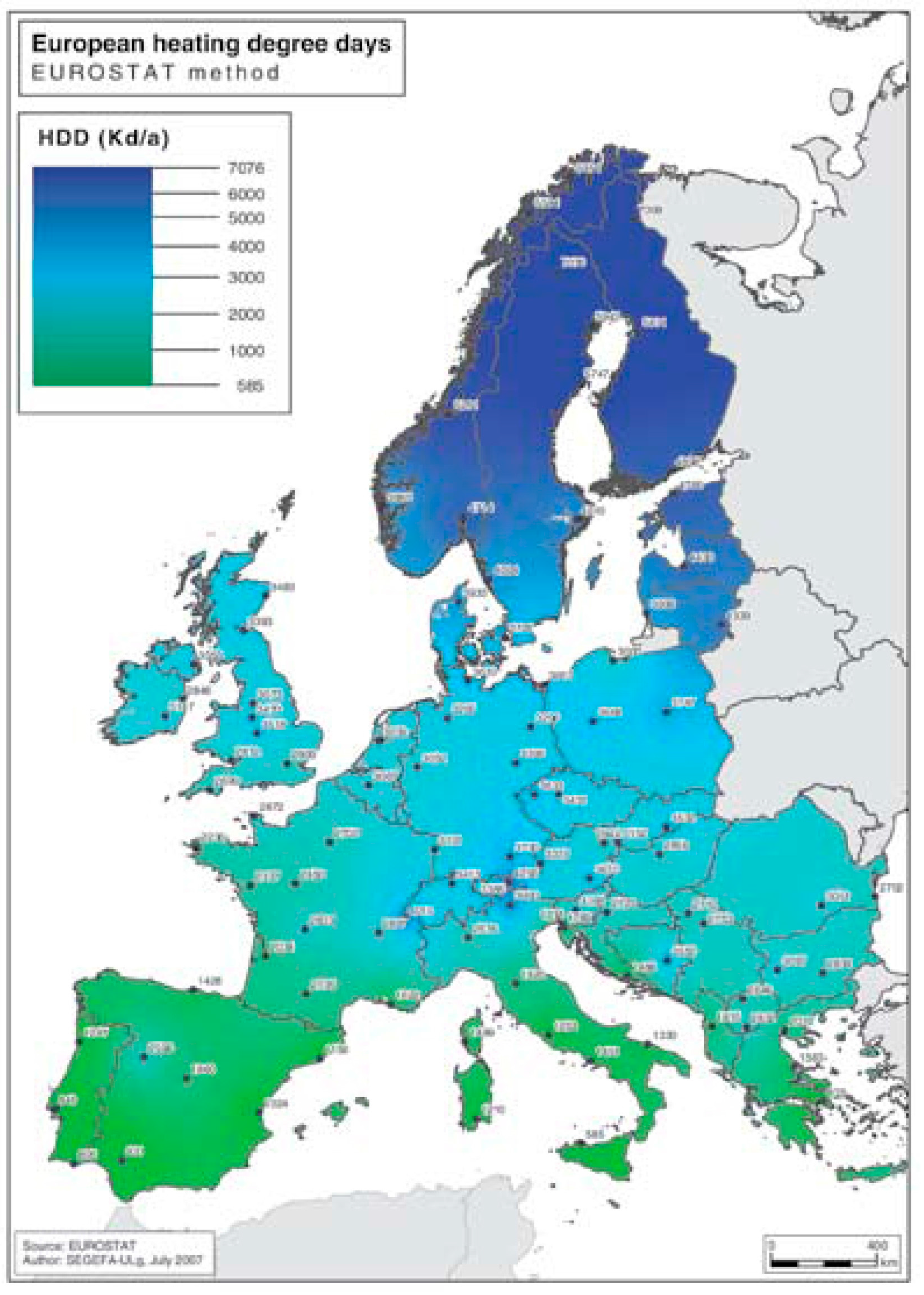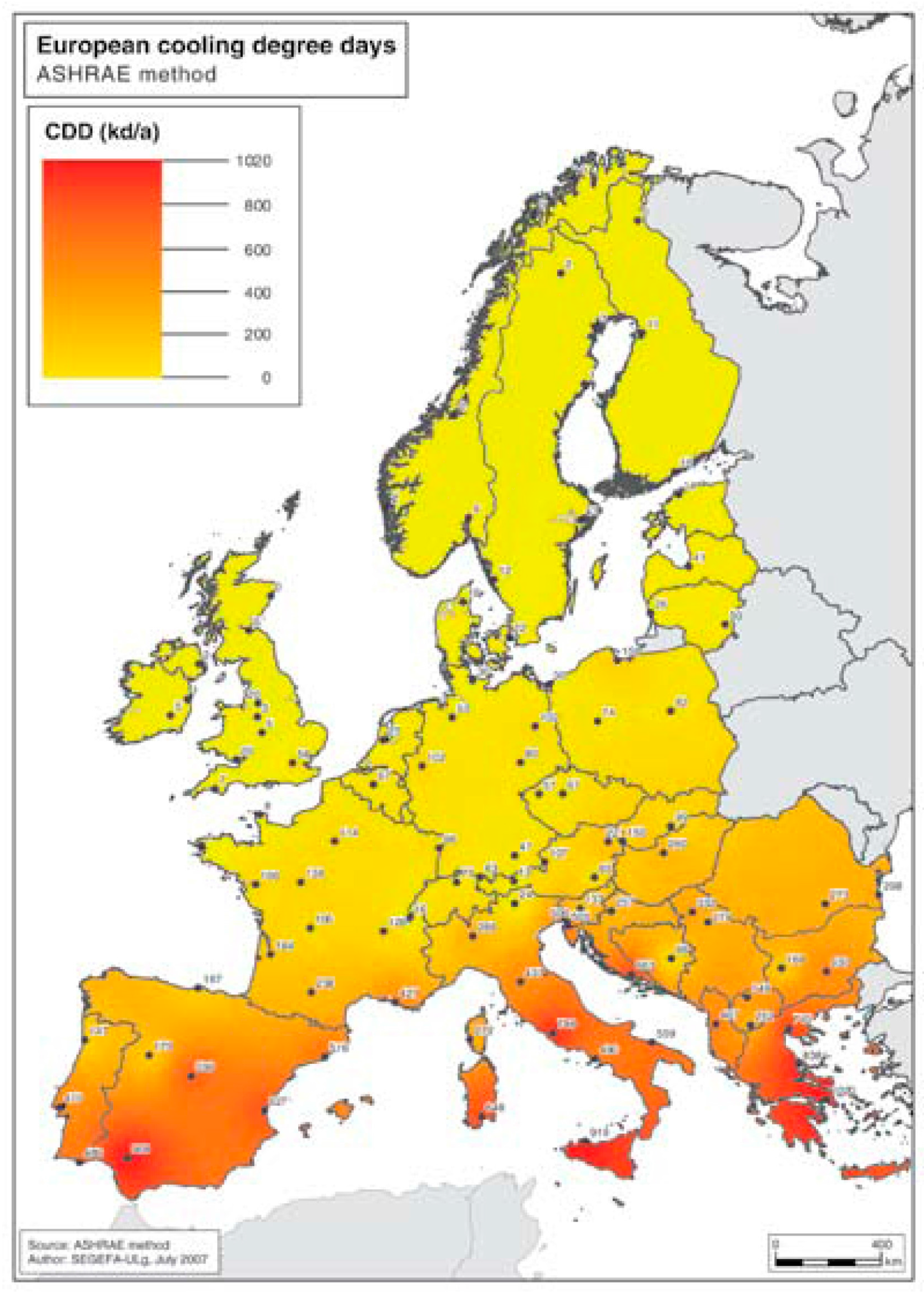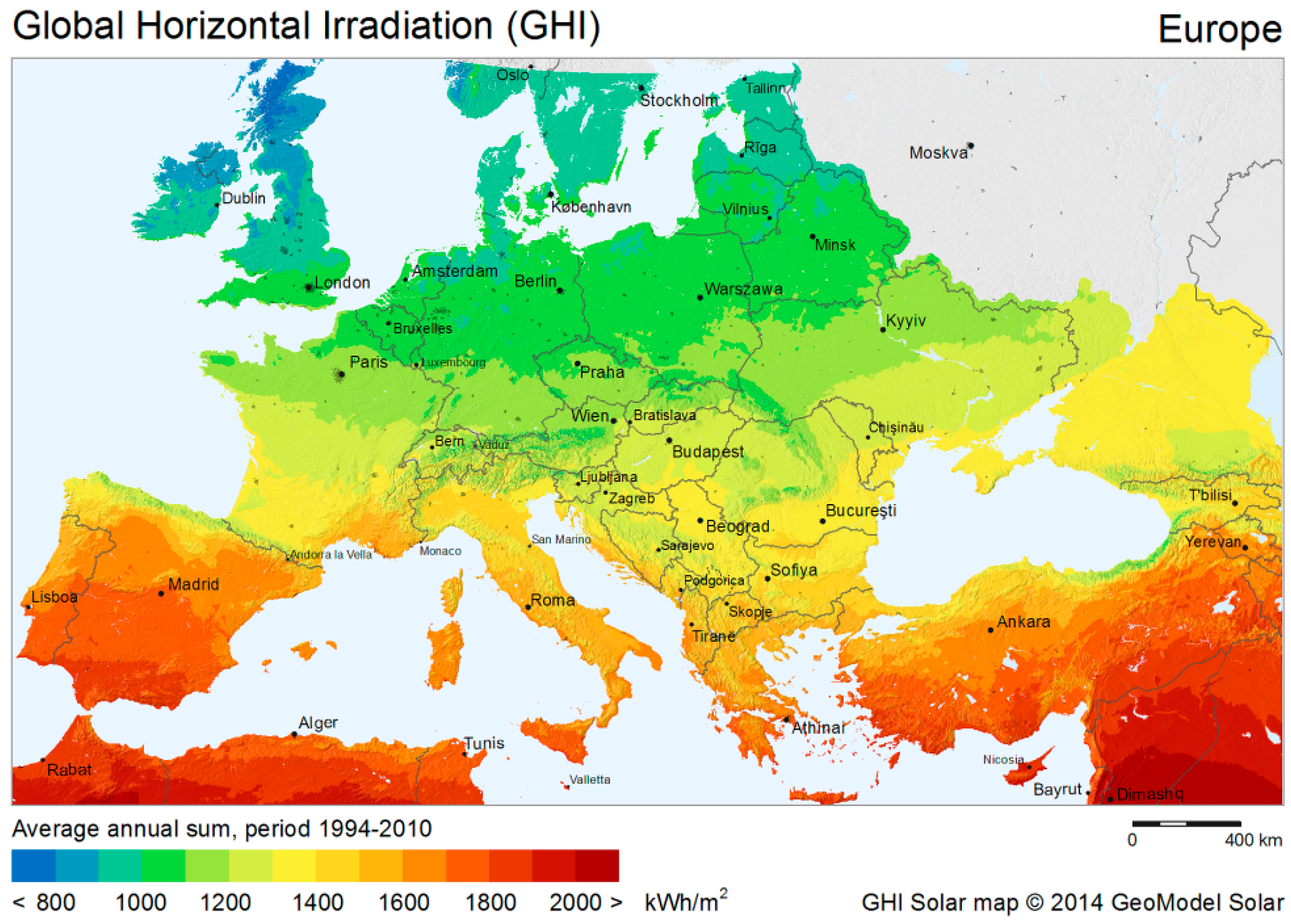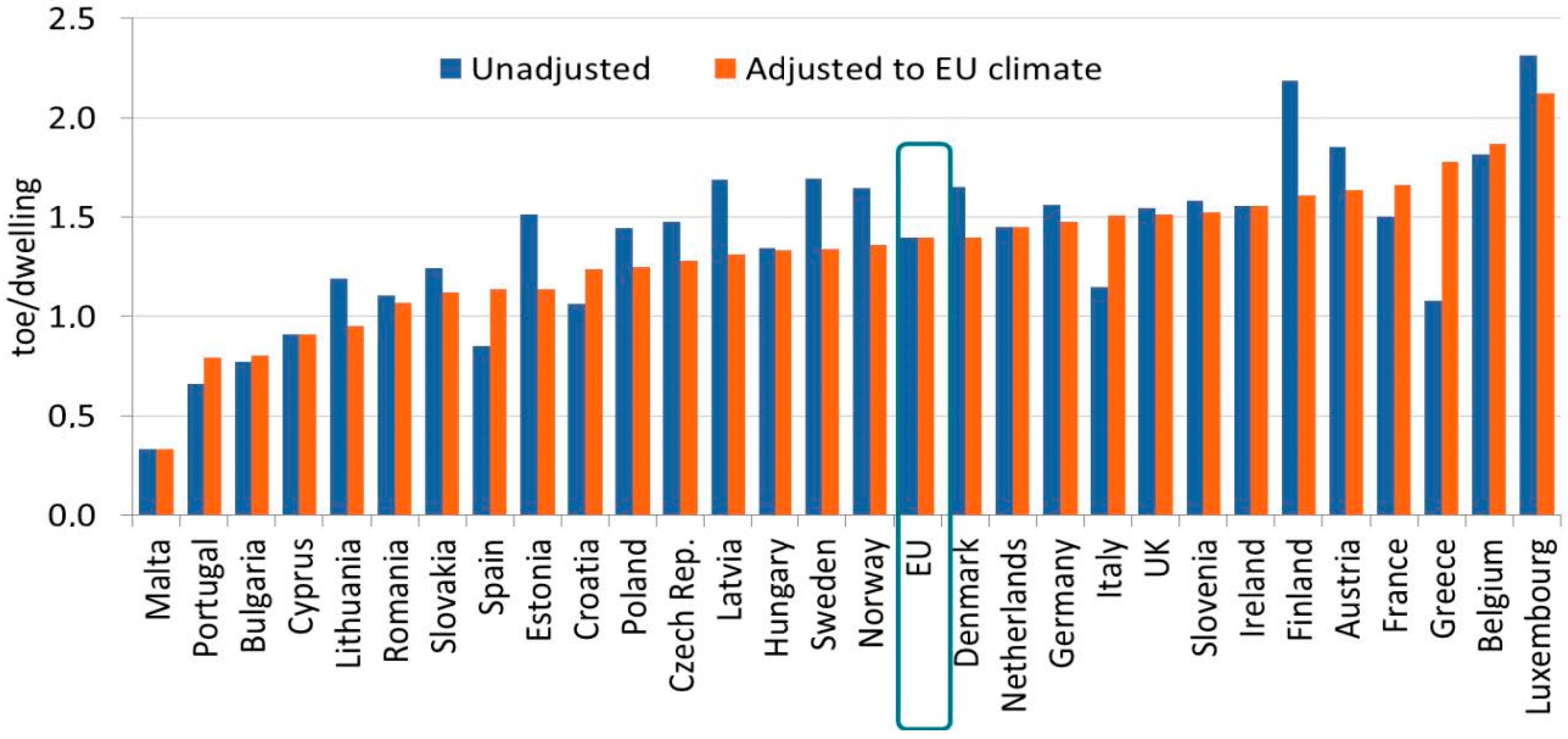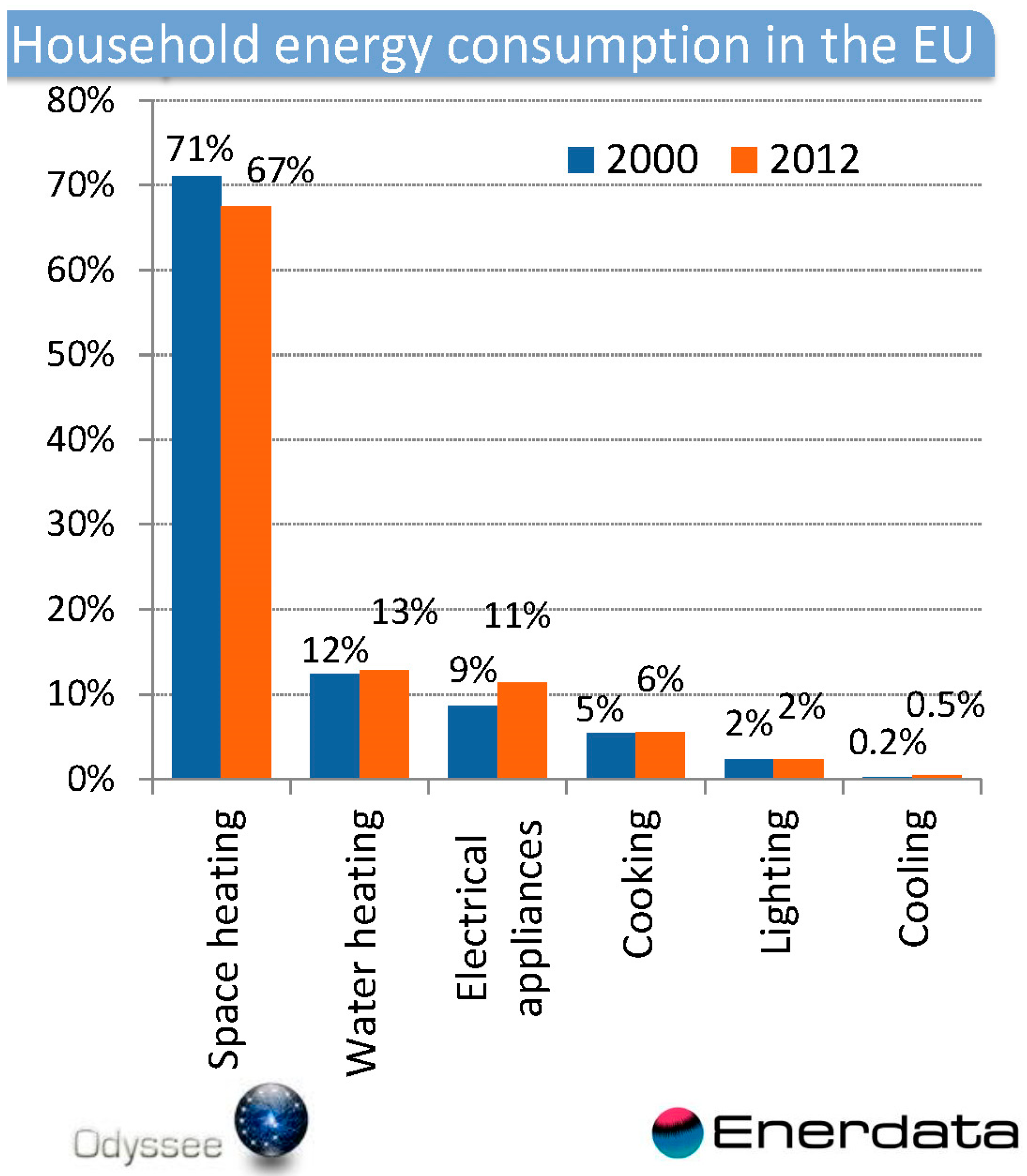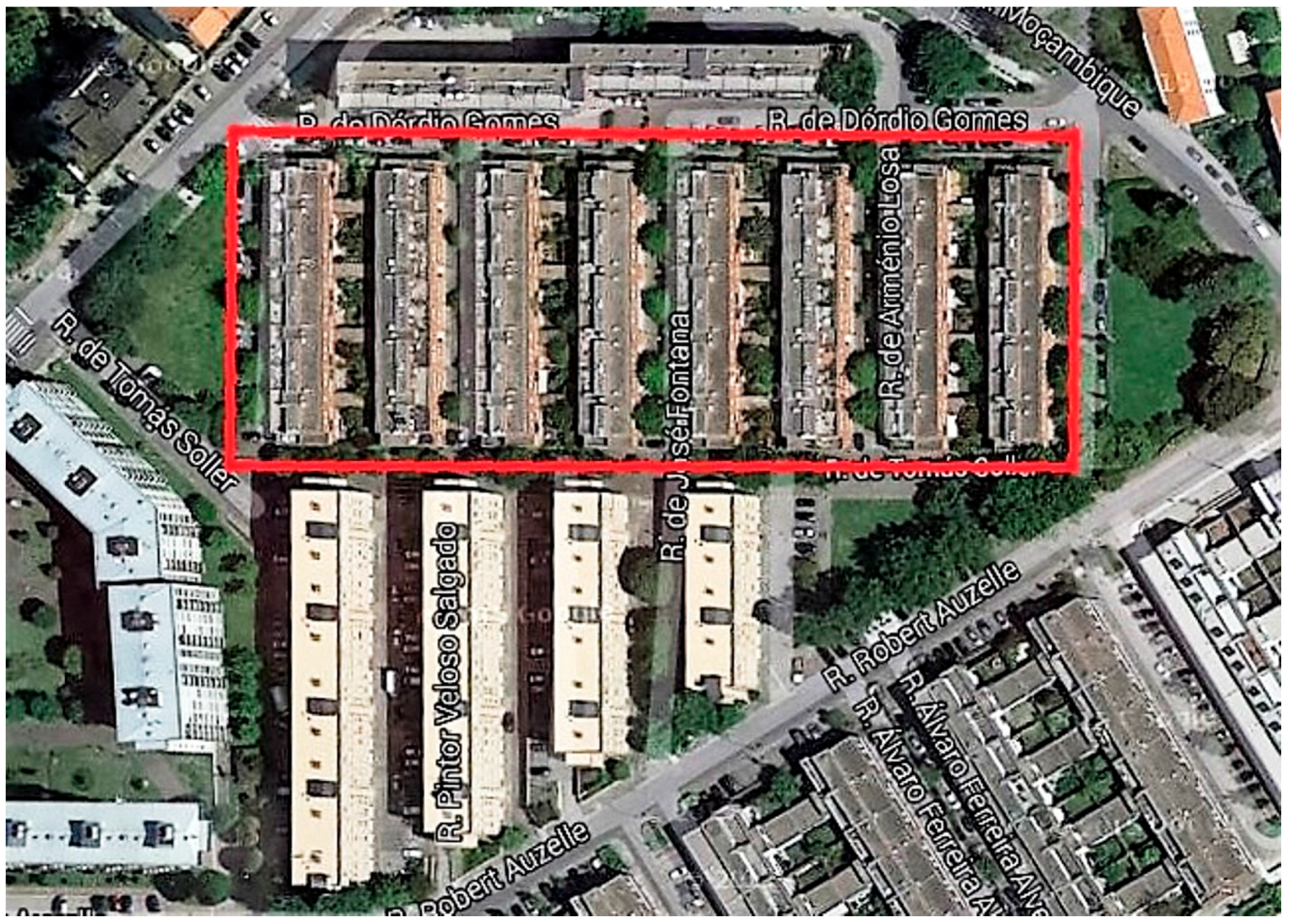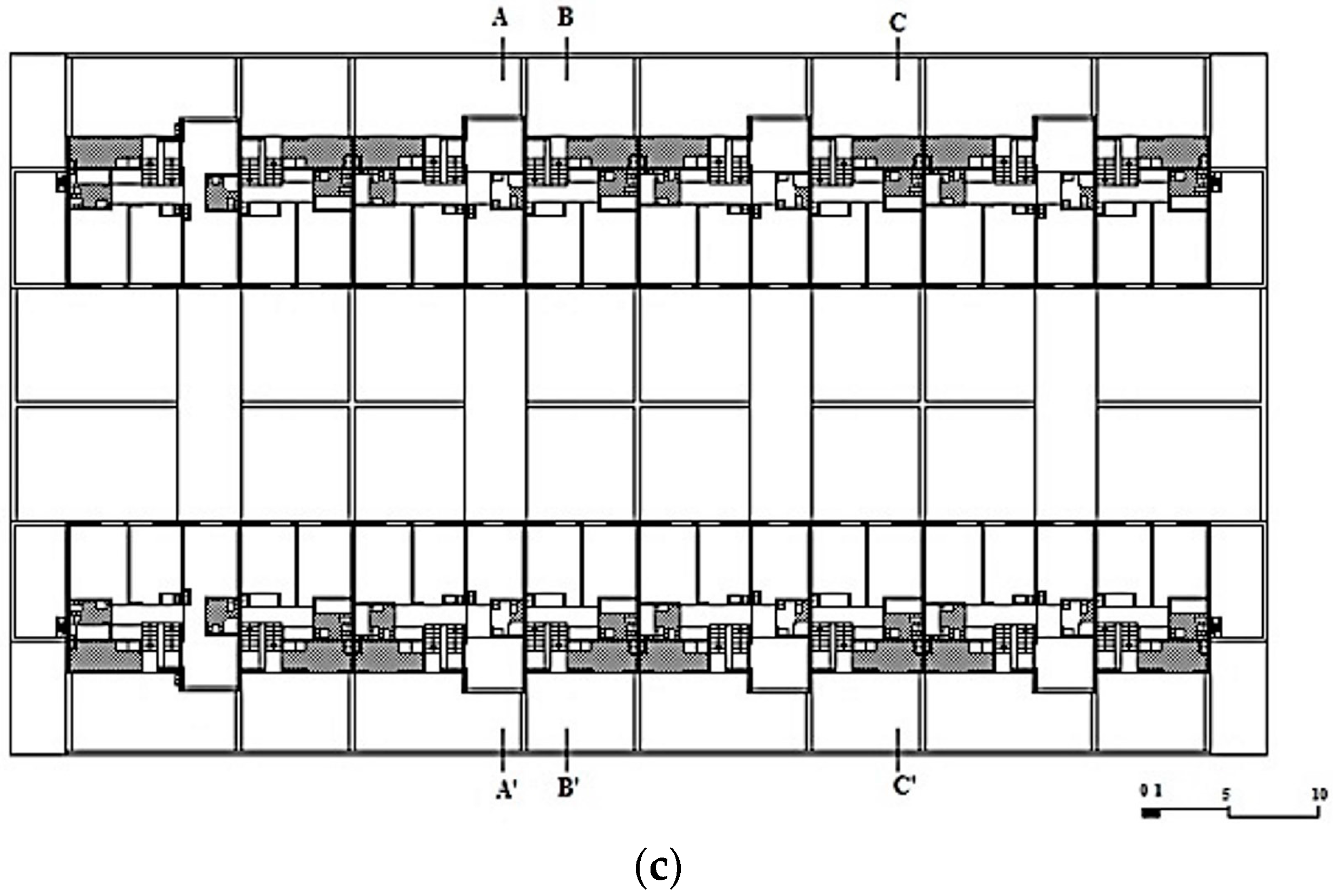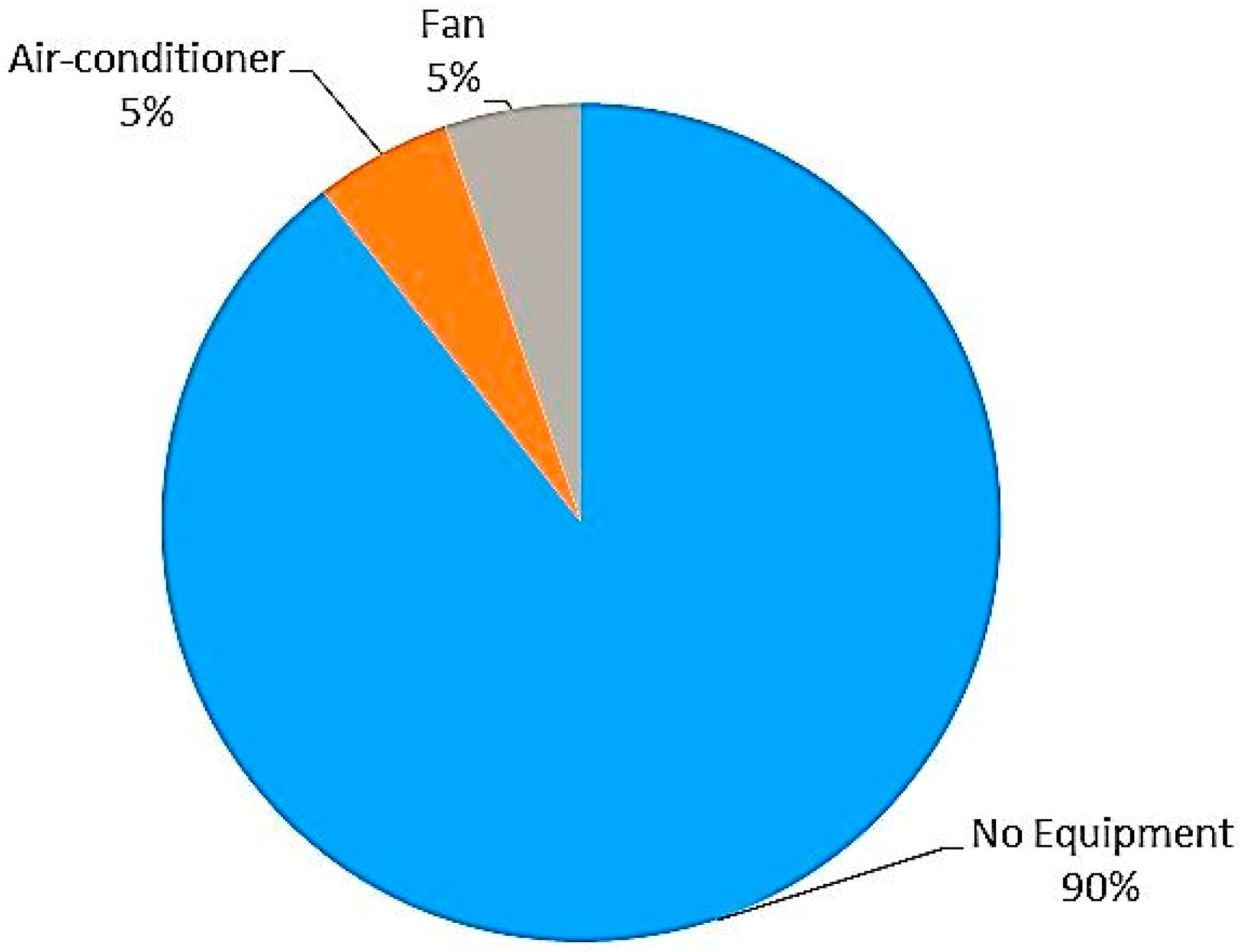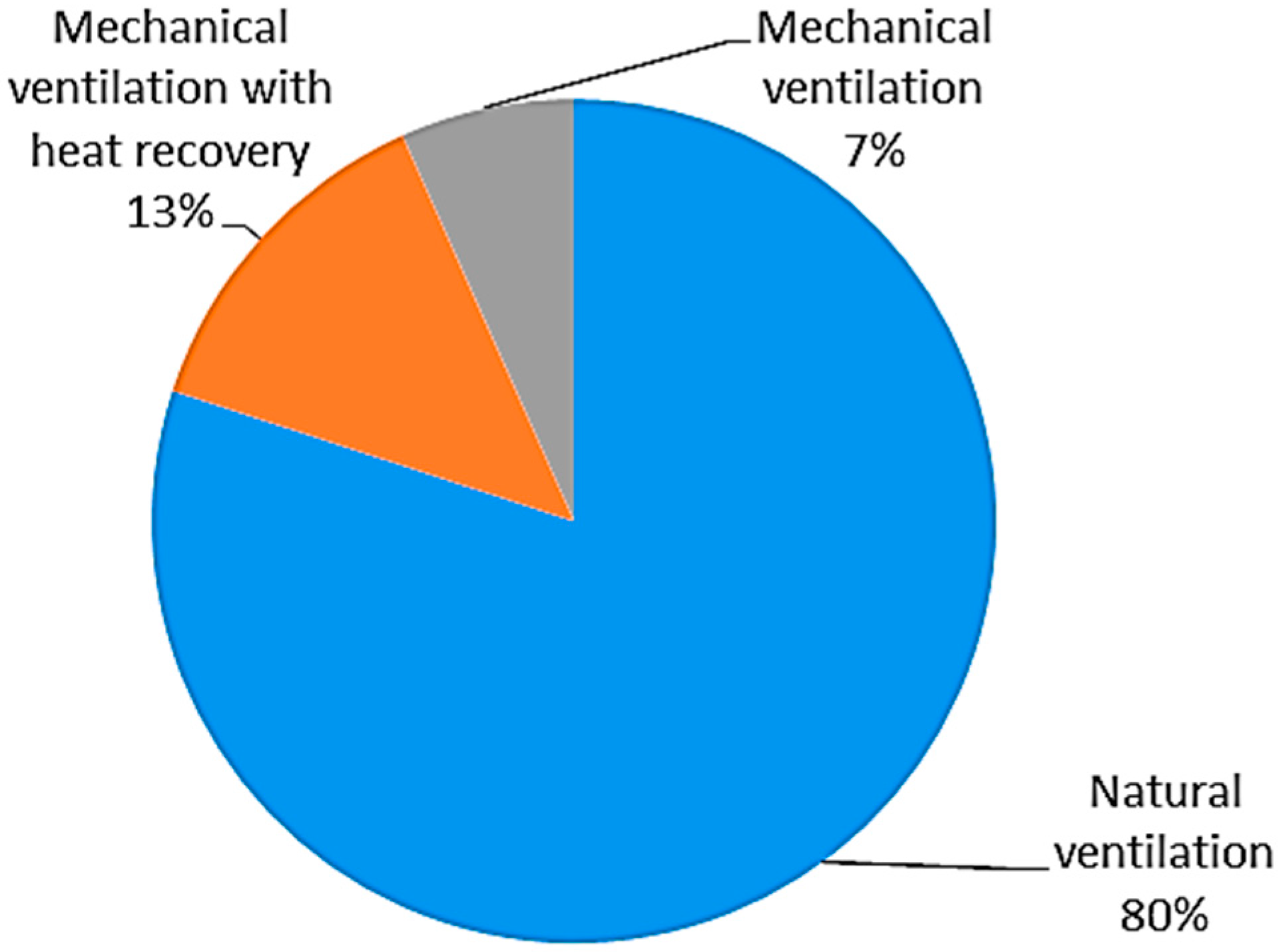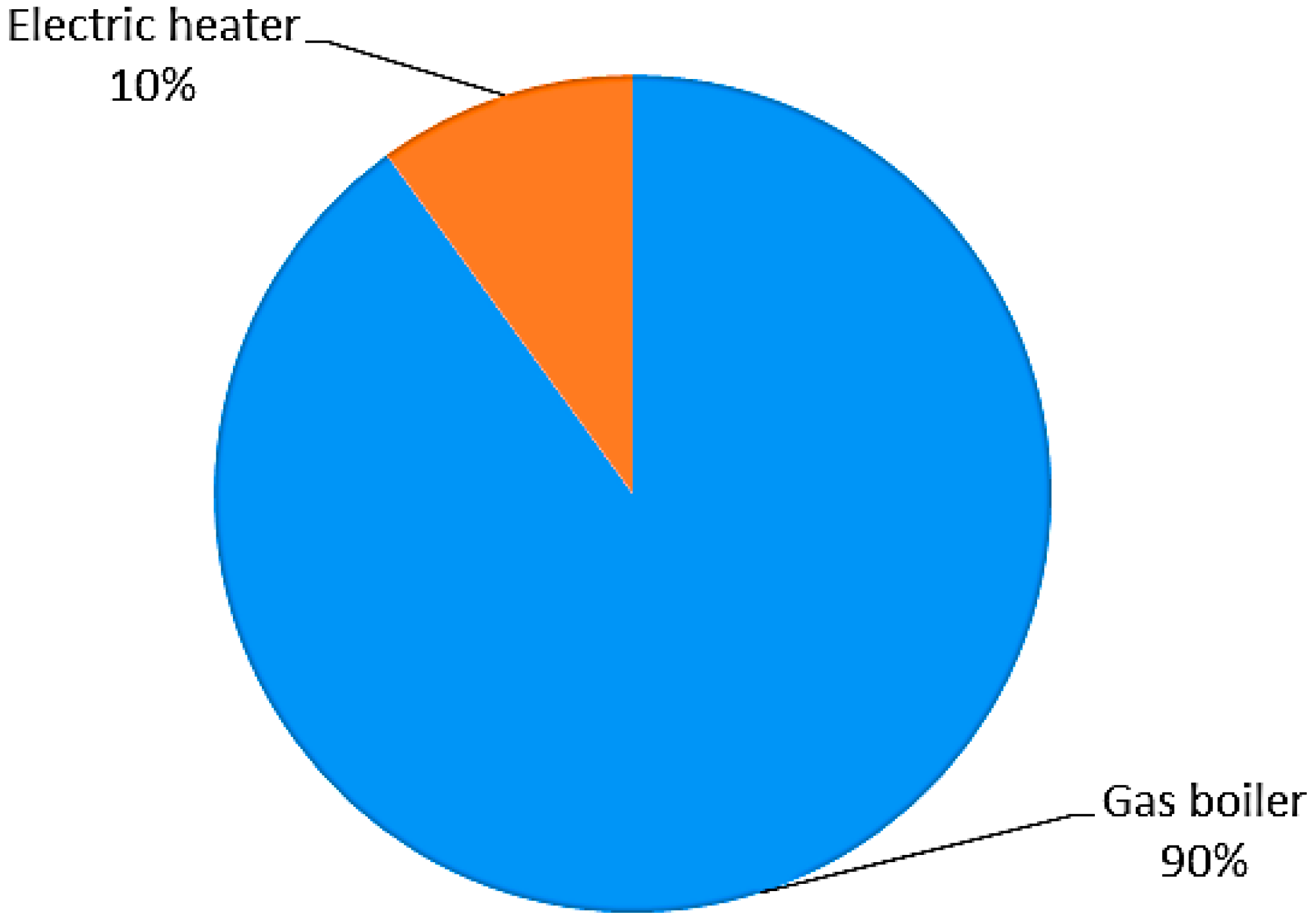4.2. Characterization of the Neighborhood
The object of the study was a set of buildings that constitutes the second phase of a wider complex, a neighborhood, promoted by a housing cooperative. The set of buildings under study (bordered by a red line in
Figure 10) is a residential complex built in 1991 and designed by architect Manuel Correia Fernandes. It consists of eight buildings (numbered from A1 to A6 and B1 and B2), with 16 apartments each, in a total of 128 apartments distributed by typology, as shown in
Table 2.
This residential complex is located in Porto, Portugal. The climate of Porto is classified as Csb Mediterranean. The mean temperature in the coldest month (January) is 9.5 °C and in the warmest month (August), 20.8 °C. The standard number of heating degree-days is 1250 °C d.
The envelope of the buildings consists of external double walls (hollow brick + air space + solid brick, with no thermal insulation) and a flat roof (a concrete slab with 0.04 m of thermal insulation). The internal concrete slabs in contact with the garages have no thermal insulation. The windows have PVC frames, a single glass with a thickness of 5 mm and external roller shutters. In
Table 3, the U-values of these construction elements are presented.
4.3. Field Survey
A field survey was carried out gathering all possible information about the following:
The field survey allowed gathering some energy bills. However, since it was a preliminary study of short duration, and given the small number of replies, it would not be possible to draw reliable conclusions about the actual energy consumption; however, with the help of the energy matrix of Porto, it was possible to define an average user profile.
The energy matrix of the metropolitan area of Porto [
14] presents, for the residential sector, in terms of final energy consumption, the following estimation for each type of use: space heating (22%); DHW (22%); domestic cold, i.e., fridges and freezers (17%); cooking (16%); appliances (16%); lighting (6%); and space cooling (1%). These are average figures and of course it is possible to find specific examples of different behaviors, depending on the building and especially on its use. However, an analysis of all the information gathered for the studied residential complex made it possible to accept this distribution as an average user profile, suitable for the purpose of the present preliminary study although certainly not enough accurate for a real intervention.
4.4. Estimation of Energy Needs
Buildings energy needs were estimated using the methodology of Portuguese thermal regulation for residential buildings, which is a steady-state methodology that follows European standards and assumes the conditions described below. It takes into account heating energy needs, cooling energy needs, energy for DHW and the contribution of possible local production of renewable energy.
For winter, the regulatory methodology considers a comfort indoor temperature of 18 °C, 24/24 h during the entire heating season. The duration of this season is defined in the regulation, for each location, based on the period for which the number of Degree Days is quantified. For Porto, the standard duration of the heating season is of 6.2 months. This means that the regulation assumes that residential buildings in Porto region are permanently heated at 18 °C during 6.2 months in the year.
For cooling season, a duration of four months and an indoor comfort temperature of 25 °C are considered by the regulation.
For the estimation of energy need for DHW, the hot water consumption is of 40 liters per person per day. The existing buildings characterized above have no installed solar collectors or any other renewable energy source.
Among the 128 dwellings of the residential complex, 16 groups were identified of apartments sharing the same relevant characteristics for the calculation. In
Table 4,
Table 5 and
Table 6, the results for the heating, cooling and DHW conventional energy needs of the buildings are presented.
4.5. Low Energy Renovation Measures
The reduction of a building energy needs can be pursued through an adequate combination of four key points: urban integration (which defines the surrounding microclimate), design strategies (whose options influences the way the building interact with the climate), building technologies (sustainable and economical viable construction solutions must be chosen) and energy efficiency of all systems and equipment used in the building.
Figure 18 represents this idea.
For existing buildings, the options are of course more limited when compared to new buildings. There can be several restrictions either physical or economical. One of the aims of the present study was the test of some possible low energy renovation measures.
After analyzing the energy needs and consumption of the studied buildings some measures were defined in order to reduce the energy needs: (a) to add thermal insulation to internal concrete slabs in contact with the garages to which important heat losses were calculated (new U-value of 0.67 W/m2 K); (b) to insulate the external walls (new U-value of 0.47 W/m2 K); (c) replacement of all the incandescent light bulbs for LED lights; and (d) replacement of all the electrical appliances presenting low energy efficiency for Class A appliances.
As seen before, the estimation of the energy needs was done for the conventional heating conditions assumed by the regulation methodology but as several field surveys have showed before and the one undertaken for the residential complex under analysis confirmed, this conventional scenario has little correspondence to the reality of heating energy consumption. In fact, the heating habits are far below this level. For the average user profile in the present case study, the percentage of 22% of total energy consumption for space heating pointed out by the energy matrix of Porto [
12] seemed to be a very plausible figure, compared to the gathered energy bills and to the inquiry to the residents. It was also noticed that the value of 22% corresponds roughly to one third of the estimated conventional heating energy needs. In practical terms this can be looked at as describing a situation where the residents only heat their houses for eight hours each day or in a third of the duration of the conventional heating season. Knowing the heating habits of Portuguese families, this seems to be a fairly accurate portrayal of the situation.
In
Table 7, a synthesis of the results for the insulation of the concrete slabs over the garages is given.
A simple calculation of the payback period for the first renovation measure (
Table 7) gives us a value of 5.3 years for standard conditions and a value of 16.3 years for the adopted average user profile. In
Table 8, the results for the thermal insulation of external walls are presented.
From
Table 8, the payback period for the second renovation measure would be 7.9 years for standard conditions and 24.2 years for the estimated average user profile.
The use of LED light bulbs saves, when compared to incandescent bulbs, about 80% of energy.
Table 9 presents a comparison between the typical 60 W incandescent light bulb and 11 W LED light bulb, with respect to cost, energy consumption and service life.
An estimation was done for replacement of 20 light bulbs in each dwelling, choosing LED bulbs with a price of 4.99 euros, meaning an investment of 99.8 euros per dwelling.
Considering the actual energy consumption of an average dwelling of the neighborhood under analysis, based on the energy bills gathered, the annual energy consumption for lighting was estimated of about 580 kWh. If this consumption were related mainly to the use of incandescent light bulbs, their simple replacement would reduce energy consumption for lighting to 116 kWh per year.
Table 10 presents the analysis in terms of costs and savings of the application of this measure, considering an electricity unit cost of 0.17 euro/kWh.
Table 10 shows that the savings would pay the investment in LED light bulbs in just a little more than a year.
In order to study the impact of the replacement of all the less efficient electrical equipment for more efficient ones, based on the analysis of current energy consumption, a value of 3500 kWh per year was considered for electricity consumption of that equipment in each apartment. For a reduction of 30% of that consumption, the acquisition of the following Class A equipment for each apartment was evaluated: a washing machine, a dishwasher, a fridge, a freezer and a stove with oven. The investment would be around €1500 per dwelling.
Table 11 presents the significant numbers for this measure.
The payback period for this measure would be at least 8.4 years.
Concerning the equipment for space heating and cooling, no replacements were considered. In the case of cooling, as
Figure 15 shows, the great majority of the apartments have no equipment. The few that have fans or air-conditioners use them for very short periods during the year so it is not significant.
In the case of heating, since very diverse solutions were found in the studied buildings and the way they are used also vary a lot, it would take a deeper analysis to be able to define a realistic approach which would fall out of the scope of the preliminary study undertaken.
4.6. Renewable Energy
Concerning local renewable energy production, the installation of thermal and PV solar systems was evaluated. For this evaluation, SolTerm software application was used which simulates and analyses the performance of solar systems, tuned to the specific climate and technical environment prevalent in Portugal. SolTerm is also the oficial certification software for calculating the energy balance of renewable energy systems, which are mandatory for all new buildings. To meet the energy needs for DHW, presented in
Table 6, solar thermal collectors were designed to be installed on the roof with an area of 1.9 m
2 each and an optical efficiency of 82%. Very well-insulated water tanks are necessarily components of the global system.
Table 12 summarizes the performed calculation.
Taking into account that, in the absence of solar systems, energy needs for DHW are covered 90% by gas (0.10 euro/kWh) and 10% by electricity (0.17 euro/kWh), a weighted energy cost of 0.107 euro/kWh was considered. The annual savings were estimated as 34,793 euros for the residential complex which means that the payback period would be around 11.5 years.
After applying the measures to reduce energy needs and sizing solar thermal collectors for the preparation of DHW, if net zero energy standard is to be meet it is possible to try to cover the remaining energy needs with PV solar panels.
To produce the energy necessary to meet the needs of the buildings, photovoltaic panels were designed as follows: groups of PV panels which comprises two modules with an area of 1.142 m
2 each, with an open circuit voltage of 24.5 V, intensity of current of 8.1 A for short circuit and a nominal power of 150 W, connected to an inverter with an output of 3300 W and an efficiency of 95% at full load and an output of 330 W and an efficiency of 88% at 10% of the load.
Table 13 presents the main information related with the foreseen installation of a PV solar system.
The annual savings with the installation of the PV system, in the theoretical hypothesis of an integral use of the produced energy, would be of 62,398 euros which means that PV system would have a payback period around 7.6 years. However, this figure can be deceiving since it would only be possible if either some storage capacity was implemented or an efficient energy exchange with the grid was in place, preferably through a smart grid. Furthermore, the preliminary calculation presented in this paper pointed to an area of thermal and PV solar systems bigger than the available area in the buildings roofs. Adaptations of the façades or the use of public common spaces would be necessary. This would imply an even more significant investment.
4.7. Smart Energy Management
As mentioned above, for the presented case study, storage capacity and its costs were not evaluated nor the sale of electricity to the grid nor the costs of the implementation of a smart energy management system. This means that no reliable calculation of the global payback period is possible. However, further research will address these important topics.
In terms of energy management a neighborhood is a geographically localized community within a larger city, town or suburb sharing a common service infrastructure, a group of households and public services served by a same electricity local Distribution System Operator (local DSO). In this context, it is important to bring together the different prosumers (consumers that also produce energy) and the DSO in order to maximize energy efficiency.
In the context of the EU FP-7 NOBEL project [
15] the relevant components for a neighborhood-oriented system were identified, from intelligent appliances to a smart distribution at a local level. Furthermore implementing a smart grid must include the following typical components [
16]:
Intelligent appliances capable of deciding when to consume power based on preset customer preferences;
Smart power meters empowering bidirectional communication between consumers and power providers for better data collection, maintenance, outage detection etc.;
Smart substations that include monitoring and control of critical and non-critical operational data;
Smart distribution that depicts self-features such as self-healing, self-balancing and self-optimization;
Smart generation capable of “learning” the unique behavior of power generation resources to optimize energy production; and
Universal access to affordable, low-carbon electrical power generation (e.g., wind turbines, concentrating solar power systems, and photovoltaic panels) and storage (e.g., in batteries, flywheels or super-capacitors).
